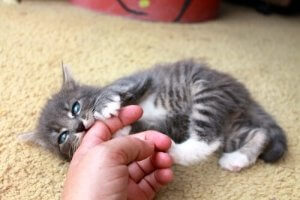Aggressive Cats: What To Do If Your Cat Is Aggressive

Anyone who has a cat knows that, even when they are showing affection, they can also hide a certain degree of aggression, and could even turn on us unexpectedly. Although it’s not common, cats can sometimes become aggressive with us. We need to know how to deal with aggressive cats, and that’s what we’ll be looking at in this article.
Why do cats get aggressive?
Feline aggression is caused by many reasons. Among the most common are:
Fear

Unlike dogs, the domestication of cats is never complete. This means they can easily go back to their wild nature at the drop of a hat.
If your cat is adopted and has shown aggressiveness with you or members of your family, one possibility is that he was mistreated previously. Because of this, he may relate human beings to pain and suffering. This, in turn, generates fear which he could try to fight against with aggression.
If this is this case, give him time. Let him adapt to his new environment. Let the cat find out for himself that your home is a quiet, peaceful place where he will find love and a place for him in the family.
Stress
There are some circumstances that your cat may not be used to. For example, he may do something wrong and become aggressive when you scold him. Being scolded might be a strange situation and he won’t know how to react. This then creates a stressful situation that he reacts to with aggression.
However, if your cat has a tendency to become aggressive due to stress or nerves when faced with unknown situations, try to introduce him to things gradually. In that way, it won’t be such a big shock for him.
Redirected aggression
Sometimes if a cat is attacked by a person or another cat that intimidates him, he may feel vulnerable. Because of that, it’s possible that he’ll then take out his anger on someone else. This is usually someone they feel superior to, and could even be you. Your cat knows you love him and believes that makes you vulnerable.
Therefore, from the beginning of your relationship with aggressive cats, it’s important to let them know that you are in charge, without taking away any love from them at the same time.
Petting
Another situation where your cat can suddenly become aggressive is when you’re petting it. This can happen for several reasons:
- To simply say “Enough is enough, thank you.”
- He was half asleep and woke up startled and defensive.
- Your cat isn’t used to being sociable.
You can tell if your cat isn’t comfortable being petted if he stops purring, moves his tail from one side to another, or twitches his back a little. If you see one of these signs, its best to get up!
“Surely oppression makes a wise man mad.”
-Bible Proverb-
How to calm aggressive cats
If your cat directs its aggression against you, there are several things you can do to defend yourself.

- A spray bottle with water. Cats hate water. Therefore, having a spray bottle in your hand never hurts. This can be useful with aggressive cats if they start attacking you or another cat.
- Get away. Leave the room and close the door. Leave the animal alone for 20 minutes. Most likely, when you open the door, she’ll have forgotten everything and come running to rub up against your legs again.
- Get down to his level. If you think your cat isn’t too angry yet, get down to his level. However, don’t stare at him, as this could make him feel threatened. Being at his height will make you look less threatening.
- Ignore it. They say there is nothing worse than being ignored. By ignoring your cat when she becomes aggressive, you can bring her down from her pedestal. She’ll soon forget why she was angry.
- Treats. Sit on the floor with his favorite treats. Let him see the treats, but don’t give them to him. Let him approach you.
All cited sources were thoroughly reviewed by our team to ensure their quality, reliability, currency, and validity. The bibliography of this article was considered reliable and of academic or scientific accuracy.
- Trillo, L. (2019). Guía para entender al gato. Fundación para el Asesoramiento y Acción en Defensa de los Animales. Recuperado el 18 de enero de 2022, disponible en: http://faada.org/docs/GuiaParaEntenderAlGato.pdf
This text is provided for informational purposes only and does not replace consultation with a professional. If in doubt, consult your specialist.